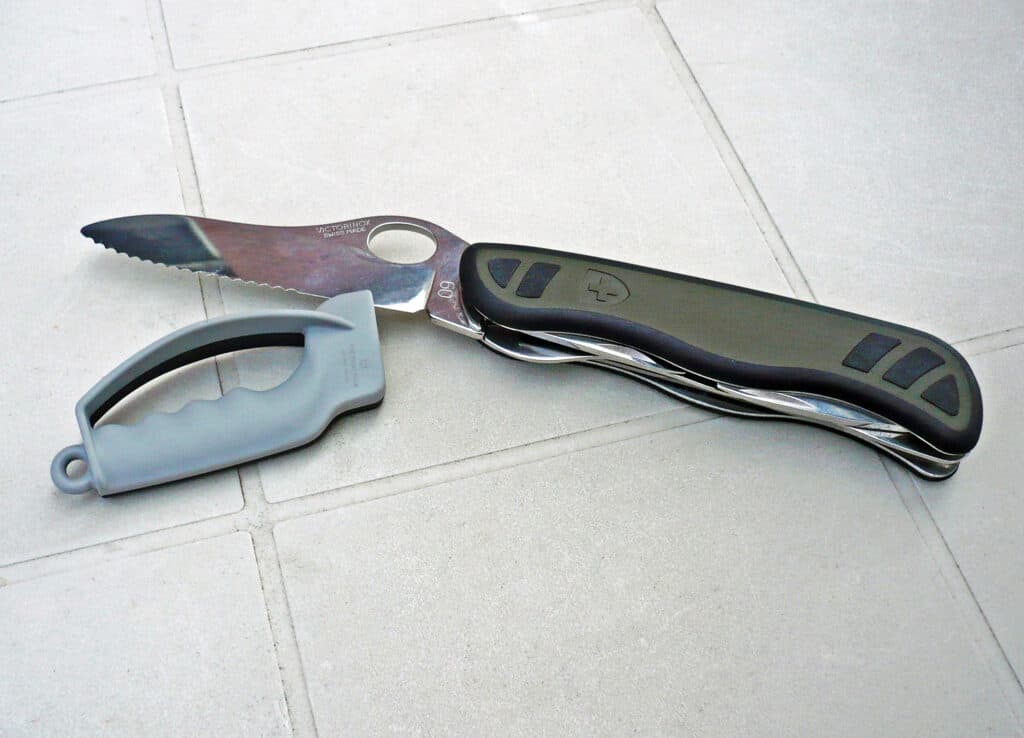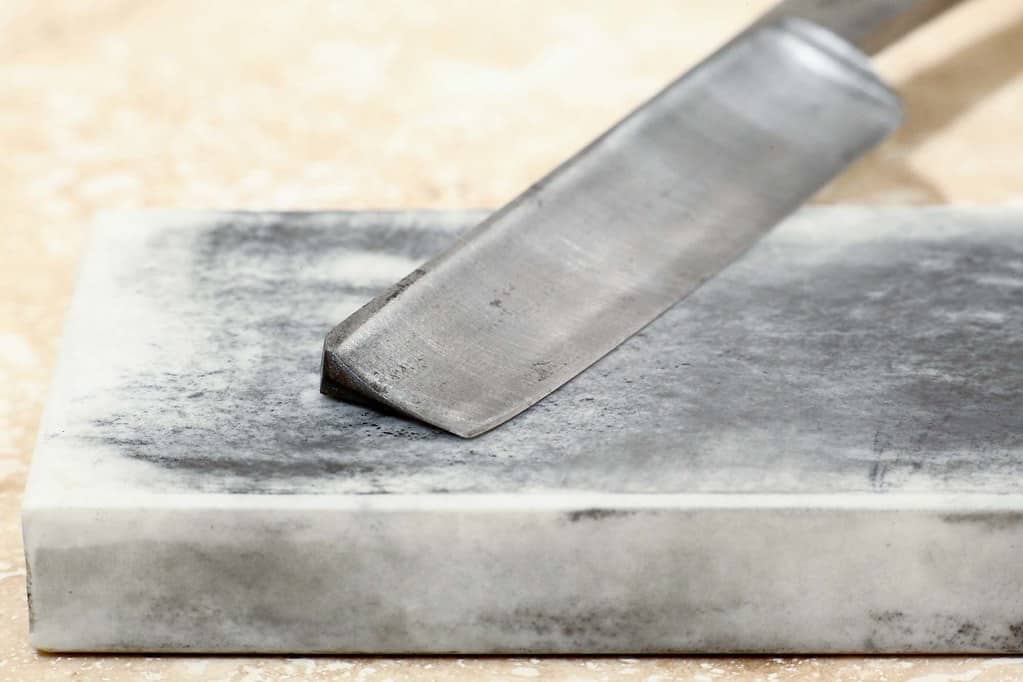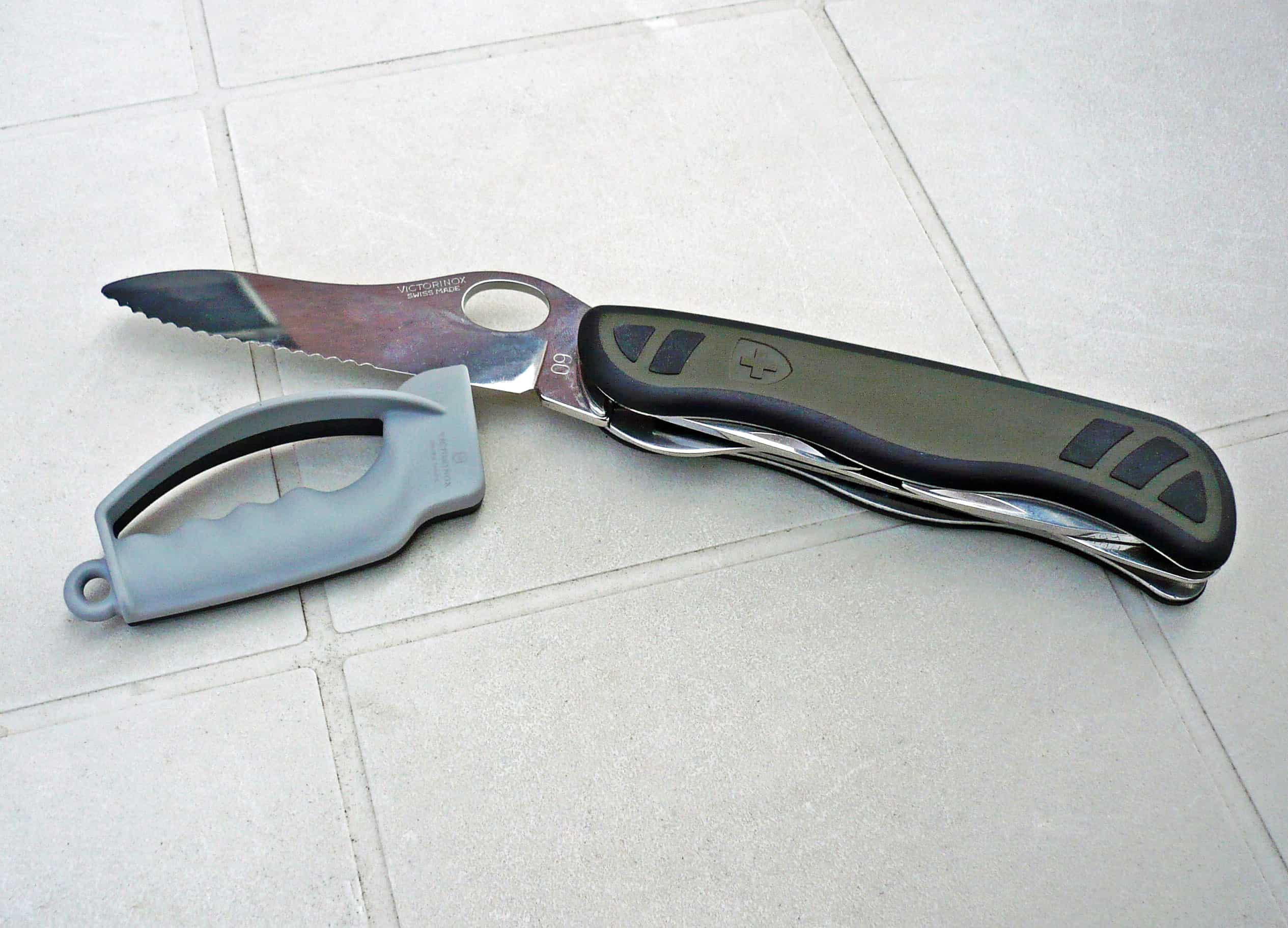A lot of people use pocket knives as an essential tool in their life. Pocket knives are useful tools which you can carry anywhere at any time which serve as a cutting or a hammering tool. Knowing how to sharpen a pocket knife correctly is very important if you own one, or are planning do.
Pocket knives can be made of one or more foldable blades located inside the handle of the knife. You can use them to open an envelope, to cut twine, slice a piece of fruit, or in extreme cases, as a self-defense tool. In this article, we will be focusing on pocket knives that have only one blade.
Sharpening a pocket knife is not much different than sharpening a regular knife. You will need the same tools and use the same techniques. Let’s check out a couple of tools you can use to sharpen your pocket knife.

If you are interested in our articles about knives you can check our guide about the best folding knives under $100 or best Elk Ridge knives.
1. A Sharpening Stone
The beauty of using a sharpening stone to sharpen your knife is that you get to choose if you want to use a more coarse stone or a finer stone which will depend on your knife’s sharpness. There are a couple of different types of sharpening stones out there:
-Whetstones: whetstones are one of the easiest tools to use to sharpen any knife and also one of the most effective. A thing that you need to know before sharpening with a whetstone is that you must soak it in in clean, cold water for at least 10 mins before starting the sharpening process. Whetstones also develop valleys with use which can make your knife sharpening process harder.
-Ceramic stones: Ceramic stones are similar tow whetstones because you will need to soak them in water as well but not as much as the whetstones, rather only for 5 minutes. Also, you should know that the ceramic ones are significantly stronger than whetstones. This is why, you’ll achieve the same results with much less work and in much less time. Also, the results from using a ceramic stone are longer-lasting than whetstones, even if it is a somewhat more challenging to use one.
-Diamond stones: You should know that diamond stones can have several coarse-grade levels – superfine, hard and fine. These stones most of the times are just metal plates that have small diamonds on the surface. Also, diamond stones are obviously, the most costly stones to buy but they last the longs out of every other type.

Preparing for sharpening
- Now, using the whetstone is rather simple, as we said you must always soak your stone in water before use. Now, there are some mineral oils that are sold to lubricate your stones which serve the same purpose. The main purpose of lubricating your sharpening stone is to minimize the chance of occurrence of the little holes that are on it from clogging with dust from the sharpening.
- Next thing you need to do is look at your knife and see the angle of your blade because it is important to maintain that angle while sharpening your knife for the best results.
How to sharpen the pocket knife
- Next you will need to position your blade at the right angle on the sharpening stone with it in an opposite direction of you, and start off with steady yet slow strokes.
Keeping your hand steady and in the right angle for prolonged period of time is hard to do, but take breaks if you really need to.
If you want to learn more about sharpening outdoor knives have a look at our how to use a Smith’s knife sharpener or how to sharpen a Hawkbill knife.
Finishing touches
- After you are done with one side, turn the knife around and do the same thing for the other side too. Remember, angle is everything.
- This step does not apply for every stone there is. But most of the time the stone that you have will have both of its sides usable, one of them is usually finer than the other. Turn the stone around and begin doing the same action with the knife as with the first side.
The test
- The test – of course you cannot be sure if your knife is sharp enough if you don’t test it out. Grab a piece of paper and try to cut is slowly with your pocket knife. If the motion is smooth and the knife doesn’t have a problem cutting the piece of paper you know you got yourself a razor sharp edge.
2. A Honing Rod
A honing rod serves the same purpose as the sharpening stone but the technique used for it is a little bit different. Most of the times they are made from steel but they can be made from other materials such as ceramic.
- Hold the honing rod by the handle and place its tip on a table.
- Know the angle of the blade on the knife that you are sharpening.
- Start stroking the knife lightly on the honing rod while always maintaining the right angle throughout your strokes.
- Do the same thing for the other side of the blade
- Test it out on a piece of paper to know if you have a sharp enough edge.
Conclusion
Hope you learned how to sharpen a pocket knife, and that it is not much different than sharpening a normal knife. It requires the same tools and the same sharpening techniques. A lot of people think that this is not the case, instead they will argue that you need special tools to do it which is simply not true. You can also use an electric knife sharpener which is a good choice but will cost you some more money.
Taking it to a professional is also always a wise idea, professionals will make sure that your knife is razor sharp and is in good shape and it won’t cost you a fortune. But the best way in our opinion is to just get a stone of your liking, learn the right angle for your knife and start stroking, once you buy a sharpening stone you will never need anything else.
More of our reviews about outdoor knives can be found in best budget OTF knives or automatic knives under $50.

Gary Portman is the founder and main author of Knivesadvice.com. With his extensive knowledge and experience, he is committed to assisting people in choosing the perfect knife for their needs. Through his articles, Gary shares valuable insights on various aspects of knives. With his expertise, readers can make informed decisions and find a knife that is tailored to their preferences and requirements. You can find more info about Gary here.

